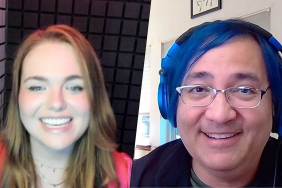
Director Tommy Lee Wallace remembers making the original IT.
Last week, following the first look at the new Pennywise in the remake, SHOCK’s Lee Gambin spoke to revered screenwriter Lawrence D. Cohen about his TV miniseries adaptation of Stephen King’s bestselling novel IT (you can read that fantastic interview here). This week, Gambin sits down with director Tommy Lee Wallace (HALLOWEEN III) to discuss his take on bringing King and Cohen’s worlds and words to life.
Enjoy…
SHOCK: How did you and fellow writer Lawrence D. Cohen set out to adapt Stephen Kings mammoth book? What was decided early on? What are some examples of what was scrapped immediately, what was workshopped to fit in a miniseries format and what were definite keepers narrative wise?
WALLACE: When I came on board, Lawrence had already written a complete script adaptation. I got a call from my agent, showed interest, and the producers sent the script over. I started reading it and decided halfway through I wanted the gig, the writing was that good. IT was set up as a two-night miniseries for CBS. I was deeply impressed with what Lawrence had done. The second part had some problems, but the first just about perfect. As fans of Stephen King know, IT is a giant of a novel and there’s enough material there to do a week-long movies-of-the-week, so to squeeze it into three hours was a tall order. Lawrence had done a very clever thing with the first part. Avid TV watchers know that television networks divide their programs into units they call “acts”. By and large, this practice of segmentation has not evolved for dramatic reasons, but simply because free television is paid for by sponsors, who want their commercials shown as often and as advantageously as possible.
In 1989, when this project was being set up, two hour movies were typically being interrupted six to eight times to sell products. Having your movie chopped up into little pieces is never what a filmmaker really wants, but in this case, Lawrence arranged the requisite act breaks in a way which, for the first and only time I know of in television, actually enhanced the drama. It was simple and brilliant. Seven acts, seven characters. Each character received their own showcase, each of which began by presenting them as adults getting the big news that It has come back! This was all inter-cut with flashbacks of their childhood group trauma, a mosaic of events which, after seven acts, completes the picture of The Losers’ Club back story and sets the stage for the second part which is their actual coming-together to re-engage with It. Just a brilliant stroke, an inspired way of structuring things, and a fine piece of writing on Lawrence’s part.

I filmed it pretty much as he wrote it. Achieving a coherent script for part two was more complicated. What happens in the book is, ultimately, an epic, supernatural face off with an iconic force of evil, featuring a battle with a giant spider, and, finally, a cosmic competition ritual played out in some inner/outer space dimension within the mind of Bill Denbrough, or perhaps within the group mind of the seven characters. It read grippingly, stretches the imagination to the limit, and was unfilmable, even if you had a zillion dollars and all the time you wanted. Hey, that “novelness” is one of the elements that made the book so pleasurable in the first place. It is, first and foremost, a literary experience, available in its totality only by sitting down and having yourself a good read. Before I came along, Lawrence (with Stephen King’s blessing, as far as I know) had decided to forego any attempt at all that cosmic stuff, and keep things on the real, in the here and now. He had also scrapped any physical showdown with the spider, instead inserting a made-up episode in which Bev’s nasty husband makes a surprise late reappearance as a pawn of It, tries to kill everybody, and winds up impaled on the horns of a large moose head mounted on the wall. Or something like that. Some climax. Something gleaned not at all from the novel, and, in my view, not helpful or relevant to the drama at hand. I felt that as adaptations go, it was as lame compared to how brilliant the first part was, and I said so. It’s one thing to simplify your source material, and it’s inevitable you are going to be forced to cut a lot of stuff, but I thought this interpretation went way too far in that direction, unnecessarily so.
I felt there was simply a lot more of the spirit of the book that was adaptable, and belonged in the movie, and the climax was such a letdown it would disappoint general audiences just the way it disappointed me. Stephen King was not actually part of these conversations. Although he and I enjoyed a cordial exchange of letters after shooting, I have never met the man in person, much to my regret. During prep and shooting he was in Maine, and we were in California. I would love to have had him along as part of these discussions, but the producers I started with made it clear that he was not in the loop. I didn’t ask whose choice that was. Sometimes you simply have to play the hand that’s dealt. I don’t think the second part quite matches the first in its magic (the emphasis shifts, after all, to the adults, and, let’s face it, even with great stars, grownups can’t match that special world of childhood) and I have no doubt that another writer, perhaps Lawrence himself, could’ve improved on what I did, but I am proud of having captured a great deal more of the spirit of the book than had been there in the second parts script when I first came on board.

I rearranged the narrative and introduced a voice-over, coming, of course, from Mike, the group’s documentarian. I did the best I could with the seven-act structure, and, most of all, I feel I captured the soulful and heartfelt connective tissue that lies at the center of the story, about the bond among these seven people. Plus, though I couldn’t do anything with the book’s climactic battle-in-inner-space stuff, I provided a legitimate horror-movie climax pretty much boiled down from events in the book, a rewrite that emotionally paid off the ultimate quest of the Losers’ Club. Stephen King is celebrated for his horrific and often twisted sense of the macabre, but I think his secret weapon, in so many of his stories, is simply that he celebrates childhood — its rituals, the silly and simple kid-things that take on iconic importance (magic stones, for example), the bonds of friendship that can last a lifetime, and the secrets — even the scary ones. Especially the scary ones.
SHOCK: Stephen King seems to love his outsider characters; those who are alien to the outside world, and this comes across in your filmic adaptation of his novel IT with the treatment of the self-named Losers Club – there is a lot of heart and sweetness in your film. How did you find the perfect balance between pathos and sentimentality with sheer terror and extremely dark material that basically dealt with the murder of children?
WALLACE: Many feel that IT is specifically about the awful subject of child molestation. That notion can certainly be gleaned, without strain, from the book itself. I captured it, I think, in that moment when Beverly is recalling the man who saw her being harassed by the bullies, but pretended not to notice. I think Stephen King built this story around this very real, very human event of horror and like good storytellers everywhere, he employed metaphor to get his point across. IT is the Great Unspoken Thing that adults refuse to discuss. IT knows your deepest secret fears, and preys on them. It knows how to weaken you, and ultimately take you for Its own; and IT makes you keep it all a secret. Aren’t the memories of this what any victim of abuse grapples with their whole life long? The balance, in the book as well as the movie, is struck by really entering that world, and living there for a little while, where, sure, there are scary, horrific things, but there are also really fun and funny and important things to be experienced, and really fine friends with whom to experience them.

SHOCK: What do you feel the major difference was in directing the adult cast as opposed to directing the children?
WALLACE: I think all children are natural actors. If they haven’t been ruined by ambitious parents, or by too much experience with glibness on camera, and if they receive the proper support, they’re going to turn in a convincing and poignant performance pretty much every time. The kids in IT were mostly still beginners at the acting trade. Seth Green and Jonathan Brandis had a bit of experience under their belts, but it appeared to me that the “old pros” recaptured their childhoods from their fellow thespians, rather than them stealing the innocence of the novices. That being said, the kids were kids — exuberant, easily bored, constantly cutting up — and, from that standpoint, required quite a bit more energy than any group of adults. They were a handful on set. You didn’t exactly want to control them, because you wanted to capture all that group interplay and energy on camera — but once in a while I’d get impatient and appeal to their budding professionalism, to focus and get the job done. The thing I’m proudest of, in casting, was that in all those character portrayals, I actually believed that that kid actually turned into that adult — one of the most challenging of casting tricks in any film. We also worked quite a bit on giving child and adult actors similar tics and mannerisms. We made a special effort to put the kids and the adults together for a few days during rehearsal, so they could work up some of those telltale traits — speech patterns, body language, Stan tugging his ear, Bill’s stutter, etc. For example, Jonathan Brandis and Richard Thomas didn’t simply come up with a stutter, independent of each other; they worked together, so that young Bill and grownup Bill stuttered in a similar way. The grownup actors were a dream. I was a bit intimidated going in — there were a lot of big names here, and I thought they might try to have me for lunch. Instead, they were all pussycats — down-to-earth, generous, supportive, consummate pros. Not to say things were stiff — it was a fun set, lots of laughs, but we worked hard.
SHOCK: What did you learn directing a piece so heavily reliant on child actors?
WALLACE: Patience. More patience. Make sure you’ve cast it well, then let ’em go. Figure out where to stand — not too close, not too far away. Those kids did so much for each other, bonded just like you see them do on the screen. Mostly I just tried to be a good scoutmaster.
SHOCK: Out of all the SFX used to make this miniseries (which included having blood spurt out of a basin, Pennywise the clown emerging from a shower drain thanks to stop motion animation and a giant spider hellbent on feasting on our misfit heroes at the climax) what proved to be the most difficult to shoot?
WALLACE: Anything involving fog, like the kid circle down in the Centrum, when IT gets to Stan – fog is always tough, but the “real” stuff is vastly superior to CGI, which, in any event, was not as readily available then as it is now; also, that little boat was kind of tricky, not the monofilament pulling it so much as getting the camera follow-shot as the boat magically reaches its final destination; ditto when Georgie was chasing the boat down the street in an early scene. It’s frequently the subtler gags that prove hardest; getting the balloon to come out of the drain and explode was easy – getting the right amount of blood to splatter on Bevvie’s face was not.

SHOCK: What is your favorite scene in the miniseries and what is your fondest memory of directing said scene?
WALLACE: I’d have to say the shots at the edge of the lake when the kids gather after their adventure and promise to come back. Those (and other shots around that lake) were done with a remote-operated hothead on a long crane — the effect of sweeping out over the water, then coming in close, the roundy-round shot of all the faces from inside the circle — speaking of subtle special effects, these were among the most technically demanding things we did, pure cinematography, and I’m deeply proud of them, not only because they were well executed, smooth, and they look cool, but because they helped the scene deliver the emotional goods, right at the heart of the movie. My fondest memory? The lump in my throat while we were shooting that scene. We were capturing something poignant and deep, about childhood. At that moment I knew we had a winner.
SHOCK: By the time IT was made Stephen King adaptations were hugely successful and/or not; but always under great scrutiny due to his massive fan base. Did this element put the pressure on when tackling one of his longest and sprawling books?
WALLACE: There was plenty hanging over me just to do a good job on a big, important miniseries. I can’t say I singled out the Stephen King fan base in my mind, to pile on the pressure any heavier. Besides, I loved the book, felt confidence in the script, I knew I was on my game, and I had great support from the producers. To be honest, 98% of the time I felt no pressure at all, just a sense of good fortune at the opportunity, and the rush and challenge of having a big job to do every day.

SHOCK: Did you always feel that you had to please the fans while making IT?
WALLACE: Every director is going to reflect from time to time on how a shot, or a sequence, will affect the audience, and of course one aims to please, and to create the desired effect, which, in the case of IT, was most often a sense of dread, and fear, and suspense and of course, an underpinning of emotional involvement. But no director in their right mind is going to use a projection of their audience as anything more than an occasional touchstone, otherwise all you’ll wind up with is filmmaking that panders, the way commercials do. As director, you’ve got to actually sit in for the audience, be their representative in a way, so finally you’re the one who has to be pleased, on behalf of everybody out there. To run around worrying too much about the fans would be madness.
SHOCK: Was there ever talk of IT being condensed to a theatrical cut?
WALLACE: Yes, but no money ever materialized to back up all the jibberjabber…









